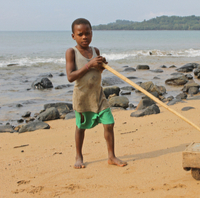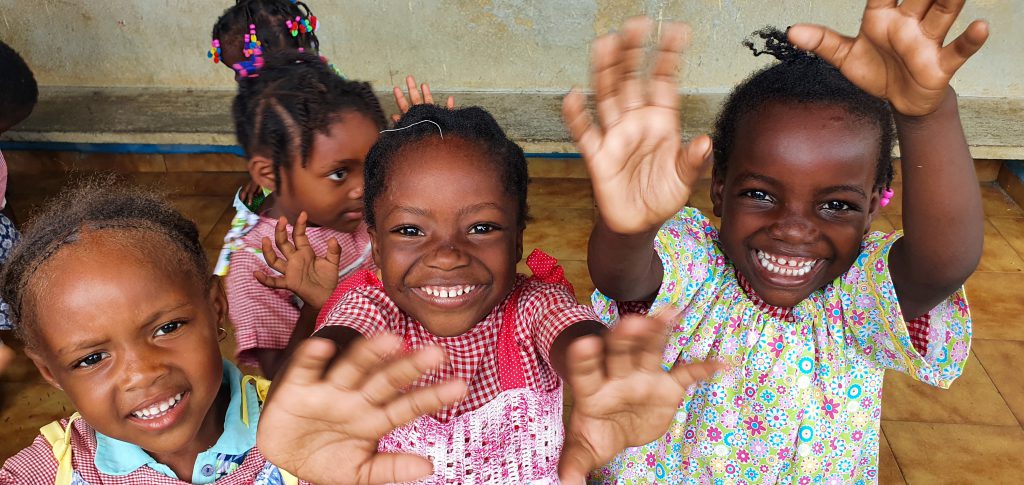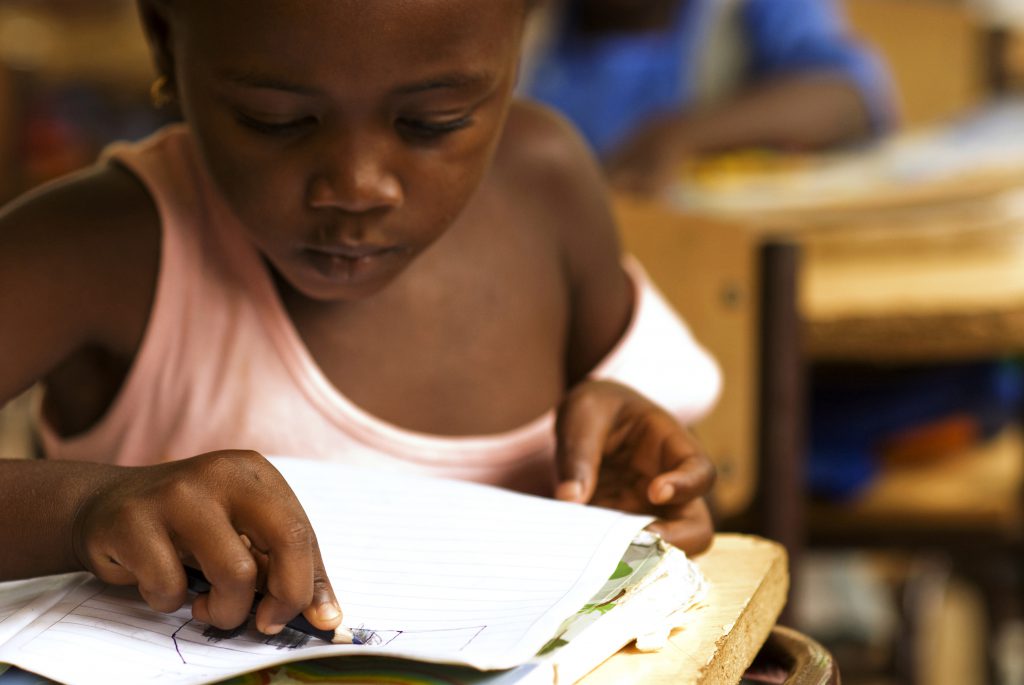Realizing Children’s Rights in São Tomé and Príncipe


While São Tomé and Príncipe has made numerous improvements in terms of access to quality education and health services for children, issues such as poverty, hunger and malnutrition as well as the lack of ratification of the Optional Protocols to the Convention on the Rights of the Child (CRC) still present a high danger to the well-being of its relatively young population (about 45% of the population is younger than 15).

Realization of Children’s Rights Index: 7,36 / 10
Red level: Difficult situation
Population: 215 056
Pop. ages 0-14: 42.15%
Life expectancy: 70.17 years
Under-5 mortality rate: 29.8‰
São Tomé and Príncipe at a glance
The Democratic Republic of São Tomé and Príncipe is a Sub-Saharan archipelago located in the Gulf of Guinea close to the equator and is about 250 km west of Gabon on Africa’s mainland. Its capital is São Tomé. The island nation shares its maritime borders with Equatorial Guinea, Gabon, and Nigeria.
Consisting of two main islands, São Tomé and Príncipe, as well as various small islets, it is the second-smallest African sovereign state after the Seychelles. The official language of the Democratic Republic is Portuguese while several other indigenous languages are spoken across the country.
The archipelago was discovered and claimed by Portugal in the late 15th century. Up until the introduction of cocoa and coffee crops in the early 19th century, the economy of São Tomé and Principe relied on the cultivation of sugar. The Portuguese colonialization period was characterized by a slaved-based economy and slave rebellions that were often brutally put down by the Portuguese colonizers.
Although in 1876, slavery was officially abolished, the Portuguese authorities substituted it with a similar oppressive working scheme of forced labour for low wages on 12 July 1975, the island nation gained independence from Portugal, but the high level of illiteracy and lack of labour skills due to the Portuguese exodus left the country on the edge of an economic crisis.
In the recent history of the country, the political environment has been one of continued instability including several failed, non-violent coup attempts. The country’s social and economic problems continued to persist at the start of the 21st century. Earnings from petroleum concessions, potential oil revenues and debt relief in the mid-2000s brought a sense of optimism in the largely foreign aid relying upon the economy of São Tomé and Príncipe.
Status of children’s rights [1]

São Tomé and Príncipe has been a member state to the UN Convention on the Rights of the Child since 1991 and to the African Charter on the Rights and Welfare of the Child since 2019. However, the Democratic Republic has yet to ratify the Optional Protocol to the Convention on the Rights of the Child on the involvement of children in armed conflict, the Optional Protocol to the Convention on the Rights of the Child on the sale of children child prostitution and child pornography and the Optional Protocol to the Convention on the Rights of the Child on a communications procedure.
Since the beginning of the 2017-2021 Programme Cycle, the Government of São Tomé and Principe has achieved important legislative and policy milestones by adopting a Family Law and Child Protection Policy, a National Social Protection Policy and a Sanitation Policy.
Addressing the needs of children
Right to education
The Democratic Republic of São Tomé and Principe has met the Millennium Development Goal on universal primary education by achieving a high and gender-inclusive enrolment rate in primary education (Human Rights Council, January 2021). However, children with special needs, especially those with mobility or hearing difficulties, are very vulnerable to exclusion from education in São Tomé and Príncipe (Human Rights Council, 2021).
Despite this high and gender-inclusive enrolment, the low quality of education at all levels leads to high dropout and repetition rates, particularly amongst girls. The lack of teachers who have received at least the minimum of teacher training adds significantly to this issue as well. In pre-primary education, only an estimated 28% of teachers received such training in primary education an estimated 27% and in lower secondary an estimated 20% (UNESCO, 2018).
The availability of second-level basic education is mainly restricted to the district capitals, which causes limited access to this form of education for a large section of the youth (Human Rights Council, January 2021). School attendance is estimated to be 94% in primary school age, 52% in lower secondary school age and 20% in upper secondary school age (UNICEF, n.d.).

The duration of free and compulsory education does not meet the recommendations made in the Framework for Action for the implementation of Sustainable Development Goal 4 (12 years of free primary and secondary education, at least 9 years compulsory) as pre-primary education is neither compulsory nor free. (Human Rights Council, January 2021) The current Educational System Act Law No. 2/2003 (Act No. 2/2003-LBSE) provides for only 6 years of free education (Article 8 Act No. 2/2003-LBSE).
These improvements towards achieving a high and gender-inclusive enrolment rate lead to one of the highest youth literacy rates in Africa with over 97% (UNICEF Data Warehouse, 2018). Despite the high youth literacy rate, young persons are affected by underemployment, which demonstrates their precarious position in the labour market, and the lack of qualifications is one cause of this youth unemployment (Human Rights Council, 2021).
Right to health
The Democratic Republic of São Tomé and Principe faces significant challenges coping with maternal, neonatal and infant mortality due to a lack of access to prenatal care and childbirth in health centres as well as due to the level of quality of care including the lack of essential drugs and equipment at maternity facilities. Despite these significant challenges, São Tomé and Principe has achieved meeting the Millennium Development Goals on improving maternal, infant mortality, combating HIV/AIDS, tuberculosis and malaria.
Three of the most troubling issues relating to the enjoyment of the right to health remain to be HIV/AIDS, tuberculosis (TB) and malaria (UNDP, n.d.). The initiated malaria programme, which covered the distribution of insecticide treated bed nets, indoor residual spraying, and diagnostic testing, targeted the general population, particularly pregnant women and children under 5.
During 2012–2016, malaria morbidity (incidence) dropped from 65.5 to 11.3 cases per 1,000 inhabitants, and malaria mortality decreased from 3.9 to 0.5 cases per 100,000 inhabitants. The extensive programmes improved the detection and treatment rates of children living with TB and HIV which contributed to this decline of incidents and mortality (UNDP, n.d.).
Hunger and malnutrition remain one of the country’s biggest challenges. Weak agriculture, fishing and livestock sectors, compounded by the impact of recurring natural hazards prevent national food production from meeting the needs of the population (World Food Programme, 2021). Surveys indicate that an estimated 6 out of 10 children in the age group of 6–59 months suffered from anaemia, as do 4 out of 5 children aged 6–23 months.
To combat child malnutrition, the government of São Tomé and Principe in cooperation with the World Food Programme (WFP) developed an environmentally and socially sustainable, gender-transformative and smallholder-friendly home-grown school meals (HGSM) programme which is part of WFP’s country strategic plan (CSP 2019-2024) (World Food Programme, 2020).
Additionally, the government made strong improvements in line with the water, sanitation and hygiene programme. While access to drinking water has improved continuously in the country, leading to an improved water source for 97 % of the population, differences in the quality of the water, depending on the distance to and quality of its source remain. As an issue remains the open defecation rate, which is among the highest in the African region. It is estimated that more than 50 per cent of the population defecate in the open (UNICEF, n.d.).
Right to identity
The right to identity is well-protected in São Tomé and Príncipe. Citizenship is governed by the 1990 Lei da Nacionalidade and the 2003 Constitution which allows for all individuals born in São Tomé and Príncipe to acquire citizenship and for both men and women to transmit their nationality to their children. For most of those born outside the country nationality is not acquired automatically from the parents, but depends on a declaration that the child wishes to acquire nationality (Article 5 Lei 6/90 da Nacionalidade).
Birth registration services are integrated with health services and are available free of charge for up to 1 year (before 2017, registration was only free in the first month after birth). The birth registration rate in São Tomé and Príncipe is very high with about 95% of children under 5 years old being registered at birth. The recently changed policy aims to reach the 5% of children under 5 years who are not yet registered (UNICEF, 2017).
Risk factors → Country-specific challenges
Poverty
As the second smallest economy in Africa, São Tomé and Príncipe faces significant challenges due to its insularity, remoteness – which translates into high export costs – and irregular landscape (World Food Programme, 2021).

While São Tomé and Príncipe had performed higher than the Sub-Saharan Africa average on the United Nations Development Programme human development index (Human Development Index: 0.625, Rank 135), extreme poverty and hunger remains one of the country’s biggest challenges (Human Rights Council, 2021). One-third of the population lives on less than $1.90 per day (international poverty line), and more than two-thirds of the population on less than $3.20 per day (World Bank poverty line). Urban areas and southern districts have higher levels of poverty incidence (Human Rights Council, 2021).
Child labour
The law prohibits all of the worst forms of child labour. It protects children from exploitation in the formal sector. While the minimum employment age for full-time work is 18 and the minimum age for non-hazardous work is 14, minors between the age of 15 and 17 can legally work up to 40 hours per week, provided employers permit them to attend school (Department of State, 2018).
Despite this, child labour remains widespread in São Tomé and Príncipe. Over 20%of children reported working in situations that violate international labour standards (United Nations Economic and Social Council, 2016). Children typically work in farming, plantations and small-scale fisheries and in the informal economy including street work at a very young age (Human Rights Council, 2021). It is also common for children to perform agricultural and domestic activities (Department of State, 2018).
Violence against children
Corporal punishment is lawful in the home. Article 86 of the Family Law No. 2/77 confirms the right of parents to punish children “appropriately and moderately”. Other laws such as the Domestic Violence Law 2008, the 2003 Constitution and the 2012 Penal Code, punish cruelty and some forms of violence and abuse of children, but do not explicitly prohibit all corporal punishment at home (Global Initiative to End All Corporal Punishment of Children, 2021).
While the government did make some efforts to reform the law to prohibit violence against children, recommendations in the Universal Periodic Review and by the Committee on the Rights of the Child to prohibit corporal punishment in all setting, including in the home, schools, and other childcare settings have not been sufficiently addressed (Global Initiative to End All Corporal Punishment of Children, 2021).
Gender stereotypes
Gender stereotypes, discrimination and multiple-partner dynamics result in an absence of social and economic responsibility by males, and the use of corporal punishment by caregivers results in high rates and normalisation of domestic violence, particularly in rural communities (Human Rights Council, 2021).
UN-Women expressed its concerns about the adolescent birth rates as well as gender based physical and sexual violence often occurring as a result of strong gender stereotypes. While a lot of work still needs to be done to move away from gender stereotypes and thus achieve gender equality, the new family law represents an important step forward by establishing 18 as the minimum age for marriage. (Human Rights Council, 2021).
Written by Alexander Weihrauch
Last updated on 26 April 2021
Bibliography:
ACERWC (March 2021), Ratifications table.
Britannica (March 2021), Sao Tome and Principe.
Human Rights Council (January 2021), Compilation on Sao Tome and Principle – Report of the Office of the United Nations High Commissioner for Human Rights (Thirty-seventh session), A/HRC/WG.6/37/STP/2.
Instituto Nacional de Estatistica – São Tomé and Príncipe (March 2021).
Lonely Planet (n.d.), History- Sao Tome and Principe.
São Tomé e Príncipe: Lei 6/90 da Nacionalidade.
UNDP (n.d.), Capacity Development for Health – Sao Tome and Principe.
UNESCO (August 2018), Country Profile Sao Tome and Principe – Sustainable Development Goal (SDG) 4.
UNICEF (2017), Annual Report 2017 – Sao Tome and Principe.
UNICEF (n.d.), UNICEF Data Warehouse – Sao Tome and Principe.
UNICEF (n.d.), UNICEF Data Warehouse – Sao Tome and Principe.
World Food Programme (2021), Sao Tome and Principe.
World Food Programme (August 2020), Sao Tome and Principe Country Strategic Plan (2019-2024).
[1] This article by no means purports to give a full or representative account of children’s rights in São Tomé and Príncipe; indeed, one of many challenges is the scant updated information on the children of São Tomé and Príncipe, much of which is unreliable, not representative, outdated or simply non-existent.

